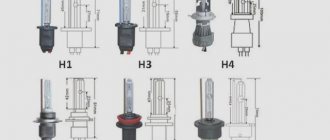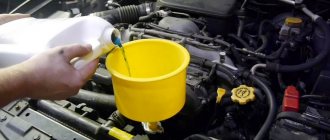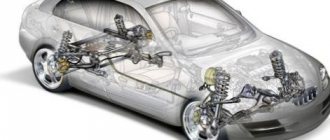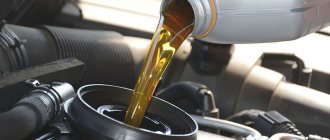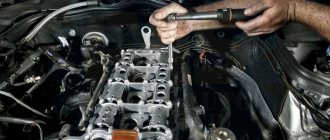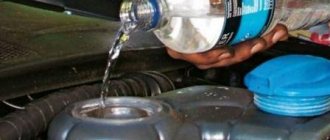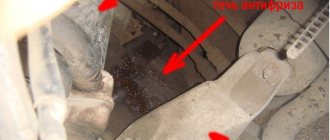Many motorists have found themselves in a situation where they have nothing at hand except a roll of duct tape and a couple of keys. In such situations, you need to “turn on” your ingenuity and reinvent the wheel. I think that many people know that if the antifreeze runs out or leaks, then you can’t move on in such a vehicle. Hence, a completely logical question is whether it is possible to dilute antifreeze with water, since water is often at hand, and the nearest store or service station is still many kilometers away.
I have a mechanic colleague who is categorically against adding water to antifreeze. They believe that this can damage the car and even lead to major repairs. I am not one of them, but my opinion and personal experience will be told in the material presented.
Antifreeze - composition, application, features of use
Any antifreeze is, first of all, a coolant. The main task of the composition is to regulate the temperature of the engine and the entire system. In summer, antifreeze prevents the power unit from overheating and from freezing in winter. The substance acquires special properties due to the fact that it contains:
- distilled water (20-35%);
- ethylene glycol (80-65%).
To prevent the formation of corrosion and the onset of other negative processes, manufacturers add special additives to antifreeze. By volume, additives can be no more than 2%, otherwise the refrigerant will acquire harmful qualities (it will corrode rubber and plastic, metal).
What to pay attention to
To immediately understand whether antifreeze is worth buying, you need to carefully look at its packaging. For example, if the package says Prediluted, this means that the composition is ready for use. In addition, it may indicate one of the following quality standards, which will indicate that this is a good liquid:
- USA – SAE, ASTM.
- Japanese – JIS.
- English – BS.
- German –VW.
- The French standard is AFNOR.
- Used in Italy – CUNA.
In addition, the classification of antifreeze differs both in composition and quality. They are divided into hybrid G11, carboxylate G12 and lobrid G12++ and G13. Their prices vary depending on this. The best choice is the antifreeze recommended by the manufacturer of the same brand as your car.
#Advice from experts
For what reason might it be necessary to dilute antifreeze?
The composition is balanced, so adding any substances to it can have extremely unpleasant consequences, but there is one caveat. The fact is that a number of antifreezes are sold in the form of a concentrate and diluting it is not only allowed, but necessary. Here it is important to carefully read the attached instructions and observe the volume of water that needs to be filled.
Each cooler has its own viscosity index, at which the composition fulfills its purpose to the fullest. It is the degree of viscosity that makes it possible for the refrigerant not to evaporate in hot weather and not to freeze in cold weather. No manufacturer recommends adding water to antifreeze unless it is specified in the factory instructions. When it comes to concentrate, you cannot use ordinary water for pouring either; it is important to stock up on distillate for this case.
What happens to the coolant in winter?
Don’t forget about the problems that can easily arise during the winter. And first of all, they lie in the fact that a working fluid diluted with water inevitably leads to a decrease in its concentration, which significantly increases the risk of freezing.
At temperatures down to minus 2, of course, nothing will happen, but if the thermometer drops below ten degrees, very much so. And this is fraught with rupture of the stove radiator, pipes, and in some cases, the motor itself.
That is why such experiments in winter frosts are taboo. Moreover, some motorists deliberately add coolant, thereby increasing its concentration and insuring working automotive components from freezing.
It is quite possible to verify the validity of such warnings by simply conducting a basic experiment at home. To do this, a small amount of pure and diluted antifreeze can be placed in the freezer and set to the maximum freezing mode.
As a result, it will be possible to see with your own eyes the crystallization of the liquid, the original composition of which was subject to changes.
In addition, we should not forget that foreign-made cars, and especially recent models, are especially sensitive to such experiments. Domestic cars produced before the 80s are another matter. Some people don't feel sorry for them. On the other hand, technology loves care and maintenance.
Under what circumstances can you still add water to the coolant?
Despite the strictest prohibitions and restrictions, there are situations that leave no choice. It happens that the antifreeze has leaked, and there is simply nowhere to get a new one. I need to drive, but I really, really don’t want to damage the car. Under such circumstances, it will be possible to dilute the coolant with water. Here it is important to strictly follow one rule - the volume of water poured should not exceed the volume of antifreeze.
If the antifreeze has completely leaked out, then there is definitely no choice and you can fill the water completely. This will allow you to get to the nearest repair shop, but you should move very slowly.
How to choose the right antifreeze
To ensure that the car runs smoothly and the coolant does not freeze, it is best to use original antifreeze. Each car brand can offer its own branded product that best suits the requirements of the cooling system of a particular car. But, if you do not have the opportunity to use such a liquid, you can use alternative solutions to the situation. Any good, high-quality brand will be suitable for refilling: European or American G11 with ethylene glycol in its composition, or G12, which is based on propylene glycol and is of higher quality. You can also purchase and use Japanese OEM antifreeze. To reduce the risk of purchasing low-quality products, it is worth considering the following factors:
- Points of sale. You should not buy liquid from uncertified places.
- Brand. It is better to choose a well-known and trusted brand.
- Compound. The final result depends on the raw materials used.
Recommendations for diluting refrigerant with water
The cooling system is an important element of the overall design of the car. Monitoring its serviceability is as important as monitoring the condition of the engine or the oil level in the engine. If there is a need to add water to antifreeze, then this must be done according to the rules in order to avoid unnecessarily negative consequences for the car.
In particular, the following recommendations can be highlighted:
- Do not add regular tap water to antifreeze. The liquid has a complex chemical composition, can quickly form sediment and cause damage to cooling systems. You can use tap water only as a last resort, but as soon as possible, head to a service station or do the flushing yourself.
- The best option may be to use a distillate. There is no need to make any special calculations regarding proportions. In summer the proportion will be 1:1, and in winter 7:3. You need to proceed from the fact that the higher the concentration of antifreeze, the less it freezes.
- A special need for topping up coolant arises in the summer, since the liquid evaporates quickly. In winter, you should not pour water into the system, since at -15 – 20 degrees, starting the engine will be almost impossible.
Controversy remains regarding whether antifreeze can be added under special circumstances. Many experts are inclined to believe that it is better to completely remove antifreeze from the system and simply pour distillate into it. For some time, this product will be able to replace technical fluid.
Causes of freezing
Manufacturers usually indicate the freezing point of antifreeze as -40 degrees or higher. But if your liquid begins to freeze even at lower frosts, then this indicates that one of the conditions for its use was not met. Among the reasons that can cause this:
- Antifreeze concentrate was used.
- The liquid was diluted in the wrong proportion or with plain water.
- In warm weather, distilled water was added to the expansion tank.
- The antifreeze was originally made poorly.
Pure concentrate cannot be used, since undiluted ethylene glycol begins to freeze at a temperature of -12 degrees. In order for the liquid to withstand frost, it must be mixed with water. It has better thermal conductivity and distributes cold more efficiently. But antifreeze can only be diluted with distilled water, otherwise scale will form, and strictly in the proportion indicated on the package.
Finding out whether it is possible to mix antifreeze of different brands and colors: recommendations from experts
Having discovered that there is not enough coolant in the expansion tank, it is worth asking what type of composition is filled. This may be specified in the instruction manual. It is quite possible that this information is printed on the container itself in the form of a sticker.
In general, the answer to the question whether it is possible to mix antifreeze of different colors is logical - it is possible if the types of coolant are the same. After all, color does not determine the composition of the coolant. In short, there are no standards for colors - this is a conventional designation adopted by the manufacturer, nothing more. For coloring, different companies can use their own pigment for the same type of antifreeze.
It’s a completely different matter when mixing formulations of different brands is done. As a result of this activity, anti-corrosion additives may conflict. The result is the formation of a solid sediment or flakes. It is quite obvious that this state of affairs will greatly reduce the life of the pump.
To avoid a curious incident involving mixing antifreezes of different classes, it is worth familiarizing yourself with their classification. There are two types of bases:
The ethylene glycol and propylene glycol they contain are polyhydric alcohols. The higher their content in the cooling mixture, the greater its frost resistance.
- Traditional (Silicate). Includes corrosion decatalysts from inorganic substances - borates, phosphates, nitrates. They cover the working surfaces with a thin protective layer, which impairs the heat transfer of the components.
- Carboxylate. Based on organic acids or otherwise carboxylates. Such additives locally resist corrosion, creating a one-micron thick protective layer in a certain place.
- Hybrid. They contain organics (carboxylates) and inorganics (nitrates, borates, phosphates). Excellent suppression of corrosive areas and counteract boiling of liquids.
- Lobridaceae. A significantly increased concentration of carboxylates and a deliberately reduced mass fraction of inorganic silicates are the main differences from hybrid compositions. It is an advanced mixture and is used on new cars.
Note. Classification from VW helps to separate types of coolants by additives:
- G11 – hybrid.
- G12, G12+ – carboxylate.
- G12++, G13 – lobrid.
You may also be interested
Is it possible to mix G11 and G12 antifreezes?
When switching from one antifreeze to another, the ideal option would be to completely drain the old one, flush the cooling system and fill in the new one. However, it is not always possible to do this. Therefore, for many drivers the relevant question is: how safe will it be to mix different coolants?
Use of antifreeze in northern regions
In many regions of our country, periods with negative temperatures prevail over the warm season of the year. In such conditions, operating cars presents certain difficulties for car owners: it is necessary to carefully select technical fluids, and in particular antifreeze. The modern Russian auto chemical market is flooded with a variety of products; the driver only has to choose a coolant that will work effectively under intense loads, […]

